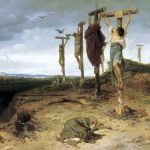Crucifixion was an extremely common form of punishment and torture, especially in cases of treason or non-citizenship. When a Roman citizen committed a crime, he was sentenced to exile or fined. A non-citizen, on the other hand, was subjected to the penalty of crucifixion even for minor theft.
Only a low-status citizen (humiliores) could have been sentenced to death – in the case of a serious crime, such as the betrayal of his own country. The convict was then tied or nailed to a large wooden cross and left there until his death. It was an extremely long and painful death.
The most famous crucifixion took place after choking during the uprising of Spartacus in 71 BCE. Marcus Crassus ordered to crucify 6000 insurgents along the Appian Way from Capua to Rome. Mass crucifixions also took place during the civil wars in the second and first century BCE and after the capture of Jerusalem in 70 CE. Josephus recalls that the Romans crucified the defenders along the walls.







